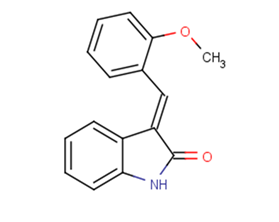
SU 5214
CAS No. 186611-04-1
SU 5214( SU 5214 )
Catalog No. M18154 CAS No. 186611-04-1
SU 5214 is a modulator of tyrosine kinase signal transduction.
Purity : >98% (HPLC)
 COA
COA
 Datasheet
Datasheet
 HNMR
HNMR
 HPLC
HPLC
 MSDS
MSDS
 Handing Instructions
Handing Instructions
| Size | Price / USD | Stock | Quantity |
| 5MG | 50 | In Stock |


|
| 10MG | 84 | In Stock |


|
| 25MG | 170 | In Stock |


|
| 50MG | 267 | In Stock |


|
| 100MG | 439 | In Stock |


|
| 200MG | Get Quote | In Stock |


|
| 500MG | Get Quote | In Stock |


|
| 1G | Get Quote | In Stock |


|
Biological Information
-
Product NameSU 5214
-
NoteResearch use only, not for human use.
-
Brief DescriptionSU 5214 is a modulator of tyrosine kinase signal transduction.
-
DescriptionSU 5214 is a modulator of tyrosine kinase signal transduction.
-
In Vitro——
-
In Vivo——
-
SynonymsSU 5214
-
PathwayOthers
-
TargetOther Targets
-
RecptorOthers
-
Research AreaOthers-Field
-
Indication——
Chemical Information
-
CAS Number186611-04-1
-
Formula Weight251.29
-
Molecular FormulaC16H13NO2
-
Purity>98% (HPLC)
-
SolubilityIn Vitro:?DMSO : 100 mg/mL (397.96 mM)
-
SMILESCOc1ccccc1/C=C/1\c2ccccc2NC1=O
-
Chemical Name3-(2-Methoxy-benzylidene)-1,3-dihydro-indol-2-one
Shipping & Storage Information
-
Storage(-20℃)
-
ShippingWith Ice Pack
-
Stability≥ 2 years
Reference
1. Silva JC,et al.Genome-wide diversity and gene expression profiling of Babesia microti isolates identify polymorphic genes that mediate host-pathogen interactions. Sci Rep. 2016 Oct 18;6:35284.
molnova catalog



related products
-
Chlormezanone
Chlormezanone, a non-benzodiazepine that is used in the management of anxiety.
-
2-ATHBI
2-ATHBI is a S1P lyase inhibitor.
-
Notoginsenoside Fc
Notoginsenoside Fc has perfect anti-platelet aggregatory effect.



 Cart
Cart
 sales@molnova.com
sales@molnova.com


